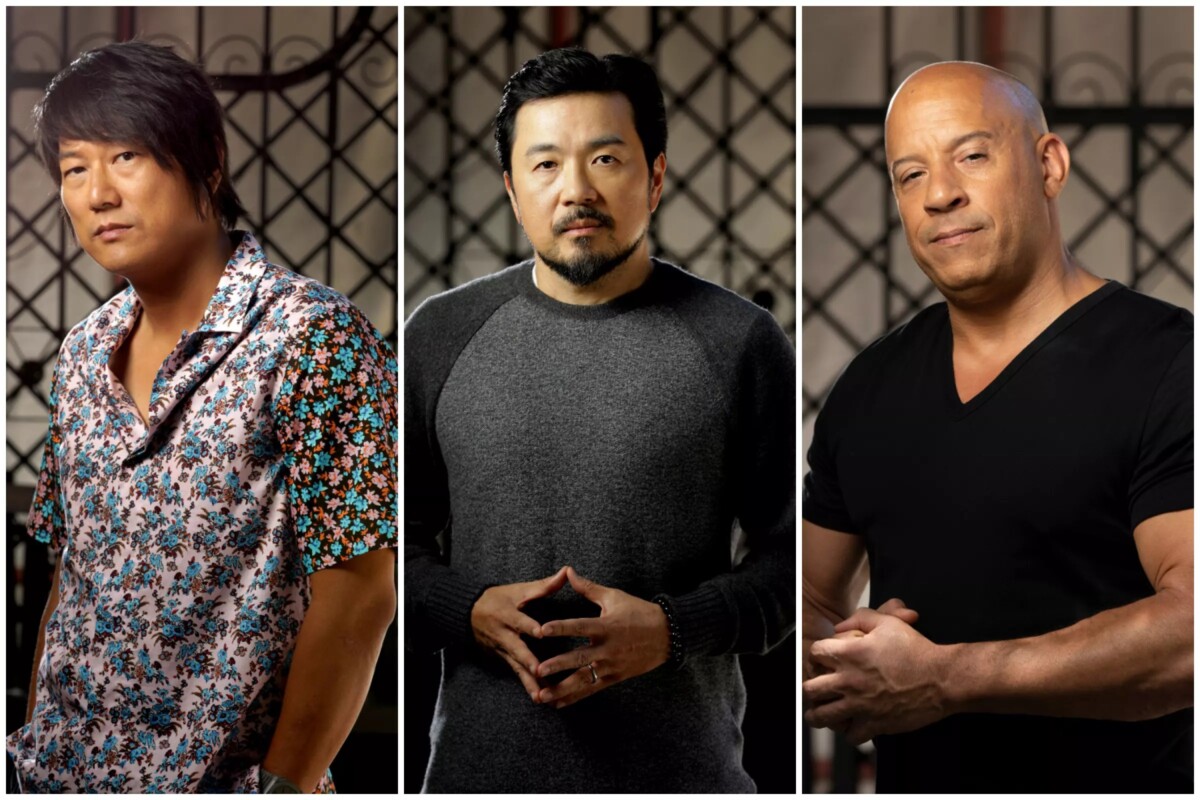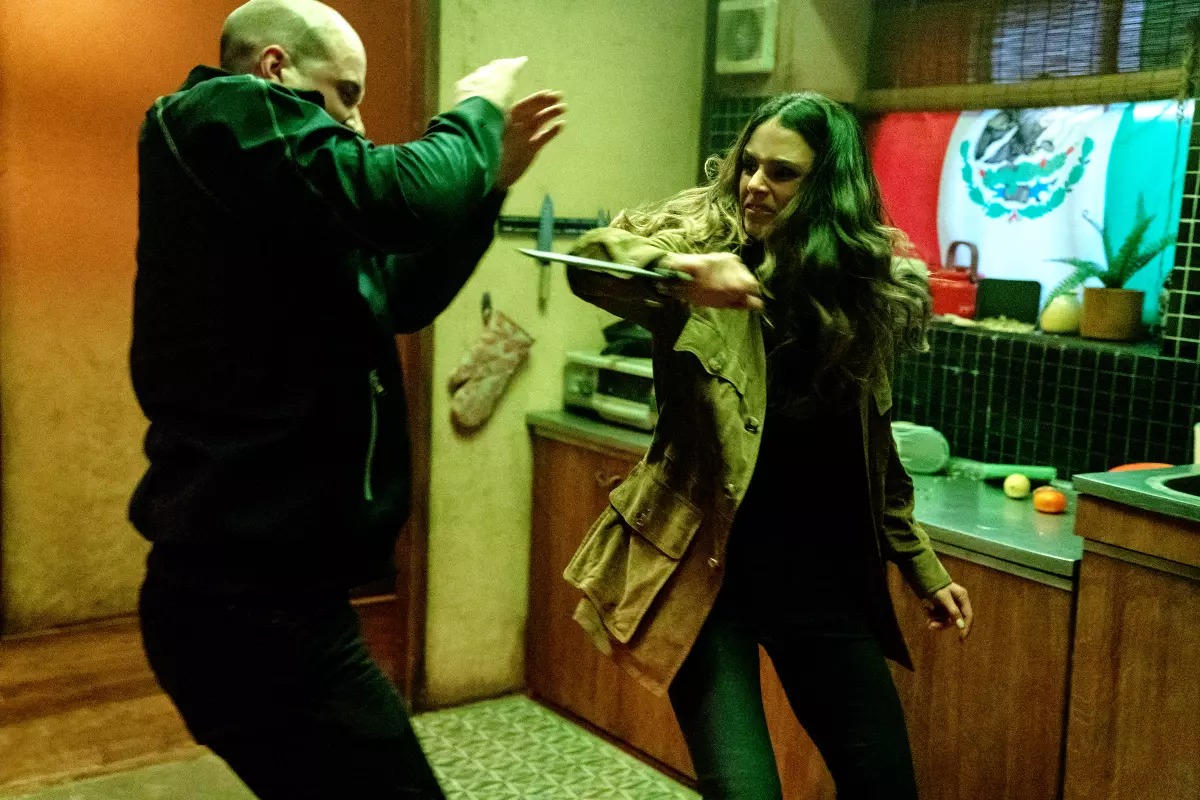
In the $6 billion-grossing “Fast & Furious” franchise, now 10 films strong, all roads lead back to one potent concept-slash-marketing hook: family. But 15 years ago, as franchise lore goes, the fateful highway that carried Justin Lin and Sung Kang to their destiny after making the third film led to … an Arby’s off the I-5.
It was there, during a 2006 roast beef sandwich stopover en route to San Francisco, that director Lin, who’d been plotting his return to indie film, saw the “Fast” future.
Having first cast Kang in his 2001 Sundance drama “Better Luck Tomorrow,” Lin had just directed him again as the cool-as-a-cucumber gearhead mentor Han in “The Fast and the Furious: Tokyo Drift.” Han met a fiery demise in a high-speed crash at the end of that movie — yet to Lin’s amazement, young fans recognized the actor and swarmed him in excitement.
Too bad he was dead in the films. But, well — did he have to be?
Fast forward six films and countless broken rules and Lin is back behind the wheel for “F9,” a sequel that, after a yearlong delay due to the pandemic, sees the Universal action franchise again reaching back to its roots with one of its key architects.

The story picks up after the events of 2017’s “The Fate of the Furious” in which the sprawling family of street-racers-turned-international-superspies, led by Vin Diesel’s Dominic Toretto, tangled with a baby-napping cyberterrorist named Cipher (Charlize Theron), fought a giant submarine on an icy tundra in their armada of shiny sports cars and topped $1.2 billion at the box office. Now Lin takes “F9” where no Toretto has gone before: into actual, literal space to save the world from a powerful weapon-hacking device, and into the past, to explain the sudden appearance of a long-lost brother (John Cena) named Jakob that no one knew Dom and Mia had.
Rules? Where the “Fast & Furious” movies have gone and are going — to at least two more saga-ending sequels to be directed by Lin — defies physics, rewrites and death, and has increasingly little use for traditional boundaries.
At its best, Hollywood’s most malleable blockbuster property has proved the value of outsized imagination, the ability to swerve and an understanding of what makes #family more than just a buzzword. At its blandest, it’s also shown that NOS, or nitrous-oxide-systems-fueled, operatics and sleeveless melodrama can carry the audience only so far.
“Good filmmaking is having the ability to pivot because that’s the true nature of making movies,” says Diesel. The face of the franchise, who set its brawny template in 2001’s “The Fast and the Furious” opposite Paul Walker, has been a producer since the fourth film (and, not coincidentally, is a longtime “Dungeons & Dragons” devotee).
Twenty years after introducing Dom Toretto to audiences, Diesel has taken the character through many stoic iterations of what familia and modern machismo mean. Exploding through genres and onto the global stage, what began as a humble $38 million B-picture about an undercover cop getting deep into street racing now sees film budgets topping $200 million apiece, with less and less runway left to keep raising the stakes.
“As filmmakers, we often have the urge to want to be clever in how we use MacGuffins and how we use our plots, and how we pull from gray areas in the past about mythology,” Diesel admits. “And for me, it’s always served me well when I acknowledge those factors and then allow my heart to guide.” Having deployed soap-opera tricks from amnesia to double-crosses to secret babies and defeating all manner of colorful enemies along the way, where might the “Fast” family go next?

Back to the spirit of 10-second cars and tuna sandwiches, and headlong into the biblical terrain of tortured brotherhood — all while keeping an eye on the horizon. But after years of development, production and release delays, and with the world still recovering from the COVID-19 pandemic, the groundwork laid out by “F9” and its box-office performance in a new era of exhibition marks an unprecedented test of the franchise’s powers of adaptability.
“F9,” scripted by Lin and “Kin” screenwriter Daniel Casey (from a story by Lin, Casey and Alfredo Botello), finds Dom initially leaning into fatherhood. He’s hiding out on a farm with his ride or die, Letty (Michelle Rodriguez), and settling for a quiet life in order to keep his young son Brian safe.
That is until he’s pulled back into the spy grind, joining Letty, Mia (Jordana Brewster) and pals Roman (Tyrese Gibson), Tej (Chris “Ludacris” Bridges) and Ramsey (Nathalie Emmanuel) to face off against his recently reemerged heel of a little brother, who possesses the Toretto family knack for precision driving, hand-to-hand combat and brooding stares — not to mention a killer case of sibling jealousy.
There was a time, Lin swears, that he thought he was out of the “Fast” game too. In 2013, having spent over half his career making the franchise, he departed after helping build the third, fourth, fifth and sixth installments into one of the highest-grossing original film franchises in Hollywood (one not based on pre-existing IP). Among other projects, he directed 2016’s “Star Trek Beyond” and executive-produced Cinemax’s martial arts series “Warrior,” based on the writings of Bruce Lee.
What he hadn’t done in his break from the “Fast” movies was watch the last two sequels, both written by franchise veteran Chris Morgan: “Furious 7,” directed by James Wan, whose installment was heavily affected by the tragic death of cast member Walker, and “Fate,” directed by F. Gary Gray.
He had heard, however, about the storyline given to “Furious 7” antagonist Deckard Shaw, played by Jason Statham. Lin had gotten Statham to appear in a “Fast 6” credits cameo that rewrote the end of “Tokyo Drift,” revealing it was Shaw who’d killed Han all along and bringing the timeline up to speed. The choice to ease Statham’s villain character into a redemptive arc two films later “didn’t compute to me,” says Lin. “I thought, why would they do that?”

His thoughts echoed the vocal fan campaign known as “Justice For Han,” which called for the “Fast” franchise, praised for its on-screen inclusivity, to do better by the beloved character than to invite his canonical killer to the family BBQ and grant him a hero’s spin-off (2019’s “Fast & Furious Presents: Hobbs & Shaw,” also starring Dwayne “The Rock” Johnson).
“It hit me at a level that, especially being Asian American, it was like, man — we have this character, and this is the way you’re going to treat him?” says Lin, letting his characteristically upbeat cadence fade for a brief moment. “But now I look back and if all of that never happened, then Han wouldn’t be back for ‘F9.’ ”
The idea that Lin had for “F9” revolved around a source of conflict that the films about the chosen Toretto clan hadn’t yet mined: family, but make it blood. At the helm with what he describes as well-earned creative latitude, Lin brought on screenwriter Casey after working with him on an unproduced project nearly a decade prior.
“A lot of people think that ‘Fast & Furious’ is just cars, just action,” says Casey, who landed the gig with a pitch filled not with action or car beats but ideas about complex family dynamics — “This all comes from being an Irish Catholic guy from Detroit,” he jokes — and the importance of writing better material for its female stars, as advocated publicly and privately by Rodriguez for years.
Those emphasis points turned into the extended flashback, set in a sun-baked Los Angeles circa 1989, that retcons an emotional foundation for Dom and Jakob’s bitter rivalry in the present, as well as overdue triumphs for its heroines.
Ramsey gets out from behind her keyboard and into the driver’s seat, as does Helen Mirren’s Queenie Shaw; Mia, oft relegated to love interest or supportive sister in the series, gets her hands dirty in combat scenes; and Mia and Letty actually sit down and check in on each other’s feelings while on a side mission to Japan where they encounter a skilled young fighter named Elle (Anna Sawai), among other surprises.

“I fought really hard for the action piece,” says Brewster, who took up tae kwon do and started sending Lin training videos to pitch herself in action. “Michelle, conversely, was like, ‘You know, our characters have never had a scene where we’re talking to each other.’ In the last 20 years, we haven’t explored our relationship.
“Since the beginning, Michelle has always been the one to say, ‘I am not playing her this way. I don’t like the way she’s written on the page, and we’re going to have to shift that. Now people are open to that in Hollywood, but 20 years ago that was not the case. Michelle was still very outspoken. She would stick to her guns, which I always respected. I didn’t have the same level of courage, but I thought, ‘wow, I really admire that.’”
“[Rodriguez] deserves full credit for how much not just time the women spend on screen, but how substantive their roles are in this movie,” adds Casey.
With the emotional bones of the story in place, he scripted on laptops and yellow pads while scouting all over the world before production filmed in 2019 in London, Edinburgh, Thailand, Tbilisi and Los Angeles. Casey and Lin molded set pieces to physical locations and consulted experts on the veracity of the science written into the action, constantly tweaking what was at one point a more than 200-page screenplay.
They listened to fan sentiment around the franchise’s twists, turns and big leaps — and wove a sense of incredulity over the Toretto family exploits into Gibson’s character, Roman, who in “F9” expresses the first glimmer of self-awareness seen thus far in the franchise. Reaching back in other ways to the “Fast” past, familiar faces reappear and come full circle, and at a brisk two-hour-25-minute runtime, “F9” is still stuffed with over-the-top car chases, VFX-aided action scenes, bone-crunching fights and fantastical spectacle.

I can go anywhere and people want to invite me into the garage, tell me about their cars and give me a Corona.
— “Fast & Furious” actor Sung Kang
But a crucial piece of the puzzle was, for a time, undetermined: the return of Kang as Han, whose plot-driving death had been depicted not once, not twice, but three times in the films (in “Tokyo Drift,” “Fast & Furious 6” and “Furious 7”). “For a long time he was not coming back alive in the present timeline — it was going to be explored in flashbacks,” says Lin.
Ever since “Tokyo Drift,” Kang had been embraced by “Fast” fans and car enthusiasts everywhere he went. “I call it the invisible key to the car community,” Kang says. “I can go anywhere and people want to invite me into the garage, tell me about their cars and give me a Corona.”
Over the years he and Lin talked over the idea of Han’s return. They’d also gotten older, stayed friends and lived life. Like the late Walker, Kang had fallen in love with car culture thanks to the films, and during the pandemic, he launched his podcast “Sung’s Garage,” connecting with the auto community. “If I didn’t have the personal life experiences, the undertone of what Han’s ‘why’ is and what his purpose is wouldn’t translate well.”
“That’s what Han is, right?” adds Kang, referring to the Korean concept of “han,” a quality his “Fast” character carried like a haunted Western gunslinger in “Tokyo Drift” — and even before that, in Lin’s “Better Luck Tomorrow,” which fans now embrace as the character’s spiritual origin story. “It’s constants like melancholy and suffering even when good happens to you, where it’s the yin and yang of life, right?”
Han’s resurrection is indeed explained in the film, and Kang doesn’t take the return for granted. “I have learned through my journey as an actor, don’t hold your breath,” Kang says. “It’s nice to be able to go on walks with your buddy and just dream together because some of them work and some of them don’t, and most ideas in Hollywood just stay on paper.”

Diesel thinks back to when he didn’t feel as free to play in Dom’s sandbox. Reluctant to cannibalize what he considered a classic after the Rob Cohen-directed first film, he says, he declined to return for the sequel, “2 Fast 2 Furious,” which was helmed by John Singleton and starred Walker and Gibson.
“I didn’t know that ultimately that the studio would allow me to produce the franchise in a more episodic fashion,” Diesel says. “If I didn’t walk away from the franchise, they may never have. Ultimately they did and that was the foundation for us to create, because now we were honoring the audience by allowing the characters to evolve.”
It was a meeting with Lin, facilitated by then-Universal exec Jeff Kirschenbaum to entice Diesel into a “Tokyo Drift” cameo, that helped bring the star back into the “Fast” fold, spitballing potential character arcs and squad history for hours. Much of it, Lin says, was woven into later sequels and into the interstitial short film “Los Bandoleros,” the only “Fast” episode that Diesel has directed.
Diesel’s brief appearance at the end of the third film tied his L.A. racer antihero to Kang’s worldly Tokyo drifter two years before Marvel adopted credits stingers to link its own cinematic universe together. Then, bending the timeline to bring the popular Han back, prequel “Fast & Furious” united what would become its core cast around Diesel, folding in characters from the previous films and adding new ones.
The studio worried that fans would be confused by the time jump, but audiences rolled with it. By the time “Fast Five” came around and tested strongly, Diesel says, his massive fan following — today, 107 million strong on Facebook alone — helped leverage a post-credits return from the grave for Rodriguez’s Letty character, who had been killed in the fourth film.
“I was adamant about the fact that you needed that character,” says Diesel, “and the character was such a part of the fabric and identity of ‘Fast and Furious.’”

Anchored by those core “family” values, Hollywood’s most inclusive blockbuster franchise has long been held as proof that diversity, and a simple universal credo, pays.
“Everyone makes fun of the sense of family and we portray a family of outcasts that are not necessarily related,” says Brewster, who alongside Rodriguez is among the rare Latina stars at the center of a blockbuster franchise. “Each one of us represents a different culture and comes from different backgrounds, but that’s always been very intentional.”
The series’ highly engaged relationship with its fans has also grown more complex the bigger and more global the “Fast” films have become, with overseas markets outpacing domestic box office in ticket sales.
A recent comment by Cena calling Taiwan a country during “F9” promotion prompted the pro wrestler-turned-actor to issue an apology to China in Mandarin, embroiling the franchise in the kind of political controversy studios studiously aim to avoid. (Lin, who is Taiwanese American, declined to comment.)
Debuting in eight overseas markets a month before rolling out in U.S. theaters on June 25, “F9” made $163 million in its first weekend. More than 80% of that take came from China. “F9” is already the biggest Hollywood opening of the pandemic era, poised to hit U.S. screens as pandemic restrictions ease stateside.
Lin and company are already in the early stages of working on the next and supposedly final installments, “Fast 10” and “Fast 11.” Lin, whose Perfect Storm Entertainment banner has a deal at Universal, first plans to direct and executive produce a pilot for NBC and Universal TV.
What he’ll say so far about the “Fast” future is that not all fan campaigns carry the same weight, and not every character can come back from the dead without a compelling reason.

“Some people say ‘Justice for Gisele,’” Lin says, referring to Gal Gadot’s character, who definitively perished in the sixth film before the actress was cast as Warner Bros.’ Wonder Woman. “But, no — ‘Justice for Han’ is not because you like him and we’re going to bring him back alive. ‘Justice for Han’ is because something really went wrong in the movies.”
True justice for the character, he adds, will be measured by what happens to Han now that the course has been corrected en route to the conclusion of the film series. “Now that we have him back,” Lin says, “it’s about how he lives on at this point on out.”
















